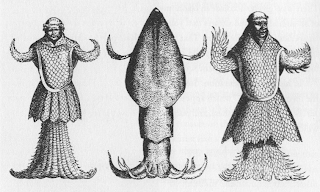In
Greek mythology, Achelous (English, pronounced
/ækɨˈloʊəs/;
Greek: Ἀχελῷος (Achelōos)) was the patron deity of the "silver-swirling"
[1] Acheloos River, which is the largest river of Greece, and thus the chief of all river deities, every river having its own river spirit. His name is pre-Greek, its meaning unknown. The Greeks invented etymologies to associate it with Greek word roots (one such popular etymology translates the name as "he who washes away care"). However, these are etymologically unsound and of much later origin than the name itself.
Origin
Some sources say that he was the son of
Gaia and
Helios,
[2] or Gaia and
Oceanus.
[3] However, ancient Greeks generally believed with Hesiod
[4] that
Tethys and
Oceanus were the parents of all three thousand river gods.
Homer placed Achelous above all, the origin of all the world's fresh water.
[5] By Roman times, Homer's reference was interpreted as making Achelous "prince of rivers".
[6]Others derived the legends about Achelous from Egypt, and describe him as a second
Nilus. But however this may be, he was from the earliest times considered to be a great divinity throughout Greece,
[7] and was invoked in prayers, sacrifices, on taking oaths, &c.,
[8] and the Dodonean
Zeus usually added to each oracle he gave, the command to offer sacrifices to Achelous.
[9] This wide extent of the worship of Achelous also accounts for his being regarded as the representative of sweet water in general, that is, as the source of all nourishment.
Mythological tradition
Achelous was a suitor for
Deianeira, daughter of
Oeneus king of
Calydon, but was defeated by
Heracles, who wed her himself.
Sophocles pictures a mortal woman's terror at being courted by a chthonic river god:
'My suitor was the river Achelóüs,
who took three forms to ask me of my father:
a rambling bull once, then a writhing snake
of gleaming colors, then again a man
with ox-like face: and from his beard's dark shadows
stream upon stream of water tumbled down.
Such was my suitor.' (Sophocles, Trachiniae)
The contest of Achelous with
Heracles was represented on the throne of
Amyclae,
[12] and in the treasury of the
Megarians at
Olympia there was a statue of him made by
Dontas of cedarwood and gold.
[13] On several coins of
Acarnania the god is represented as a bull with the head of an old man.
[14]The
sacred bull the
serpent and the
Minotaur are all creatures associated with the Earth goddess
Gaia. Achelous was most often depicted as a gray-haired old man or a vigorous bearded man in his prime, with a horned head and a serpent-like body. When he battled Heracles over the river nymph Deianeira, Achelous turned himself into a bull. Heracles tore off one of his horns and forced the god to surrender. Achelous had to trade the goat horn of
Amalthea to get it back.
[15] Heracles gave it to the
Naiads, who transformed it into the
cornucopia. Achelous relates the bitter episode afterwards to
Theseus in
Ovid's
Metamorphoses.
[16] Sophocles makes
Deianeira relate these occurrences in a somewhat different manner.
[17]The mouth of the Achelous river was the spot where
Alcmaeon finally found peace from the
Erinyes. Achelous offered him
Callirhoe, his daughter, in marriage if Alcmaeon would retrieve the clothing and jewelry his mother
Eriphyle had been wearing when she sent her husband
Amphiaraus to his death. Alcmaeon had to retrieve the clothes from King
Phegeus, who sent his sons to kill Alcmaeon.
Ovid in his
Metamorphoses provided a descriptive interlude when
Theseus is the guest of Achelous, waiting for the river's raging flood to subside: "He entered the dark building, made of spongy pumice, and rough tuff. The floor was moist with soft moss, and the ceiling banded with freshwater mussel and oyster shells."
[18] In sixteenth-century Italy, an aspect of the revival of Antiquity was the desire to recreate Classical spaces as extensions of the revived
villa. Ovid's description of the cave of Achelous provided some specific inspiration to patrons in France as well as Italy for the
Mannerist garden
grotto, with its cool dampness,
tuff vaulting and shellwork walls. The banquet served by Ovid's Achelous offered a prototype for Italian midday feasts in the fountain-cooled shade of garden grottoes.
At the mouth of the Achelous River lie the
Echinades Islands. According to Ovid's pretty myth-making in the same Metamorphoses episode, the Echinades Islands were once five nymphs. Unfortunately for them, they forgot to honor Achelous in their festivities, and the god was so angry about this slight that he turned them into the islands.
Achelous was sometimes the father of the
Sirens by
Terpsichore, or in a later version, they are from the blood he shed where Heracles broke off his horn.
[19]In another mythic context, the Achelous was said to be formed by the tears of
Niobe, who fled to
Mount Sipylon after the deaths of her husband and children.
In Hellenistic and Roman contexts, the river god was often reduced to a mask and used decoratively as an emblem of water, "his uncut hair wreathed with reeds".
[20] The feature survived in Romanesque carved details and flowered duruing the
Middle Ages as one of the Classical prototypes of the
Green Man.

